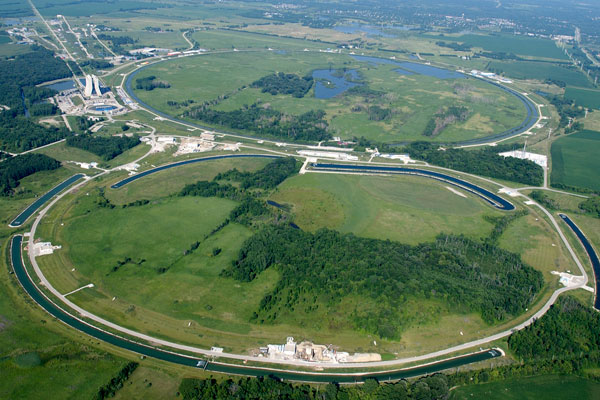
Friday marks the end of Fermilab's Tevatron, and the "era of big American physics is about to end":
It seems unlikely that the United States, which once dominated the field and reaped the rewards of discoveries and technological innovations, will be able to muster the resources to build the next big particle physics project. Long-term funding is simply too hard to come by.
That era, though, was on thin ice from the beginning. Fermilab exists—allegedly—because of a backroom deal cut between Everett Dirksen and Lyndon Johnson, and free land was an expected part of the bargain (in a tragic bit of NIMBYism, Science reported at the time that South Barrington was originally in the lead for Fermilab, but residents feared the physicists would "disturb the moral fiber of the community"). The brilliant physicist behind Fermilab, Robert Wilson—wonderfully profiled by science writer Jeniffer Ouilette here—quit and headed for Europe when he felt the Carter administration was shortshrifting the Tevatron funding, after previously getting shafted in the lab's initial construction and continuing operation. As the Trib's Ronald Kotulak wrote in 1978:
He resigned in despair because funding for his laboratory is so restricted that the facility has been able to operate at only 50 percent capacity.
The government has also delayed plans to build a new "wonder" machine, called the Tevatron, at Fermi. The Tevatron is designed to probe the conditions that existed at the birth of time….
Through ingenous designs and new technology, the Tevatron could be built for about $35 million by "piggybacking" it on the existing four-miles-in-circumference atom smasher. To build such a machine from scratch would cost about $1 billion.
Wilson hoped to have the Tevatron completed by 1980. But the Department of Energy said there is not enough money available now, so construction must be delayed two years.
The story of the Tevatron has been one of restrictions and compromise from the beginning; in some ways it's a wonder it lived to be about 30.
But as Devin Powell writes in ScienceNews, the era of the Tevatron isn't entirely over. There's a legacy in its data:
But even after the Tevatron has been embalmed, its liquid helium lifeblood drained away, the work won’t be done. Some Fermilab scientists will spend months, others years, digging through the pile of information left behind: about a million billion recorded collisions between protons and their antimatter counterparts, antiprotons.
[snip]
Some scientists believe the condemned machine still has something to say about the Higgs boson. This particle, whose existence would confirm the mechanism thought to give mass to other particles, has never been caught in action. With the LHC now the uncontested front-runner for this discovery, the Tevatron may still be able to help by narrowing the search, playing Horatio to the LHC’s Hamlet.
If that's opaque, this 2009 video from Fermilab helps explain the process:
Photograph: Department of Energy


